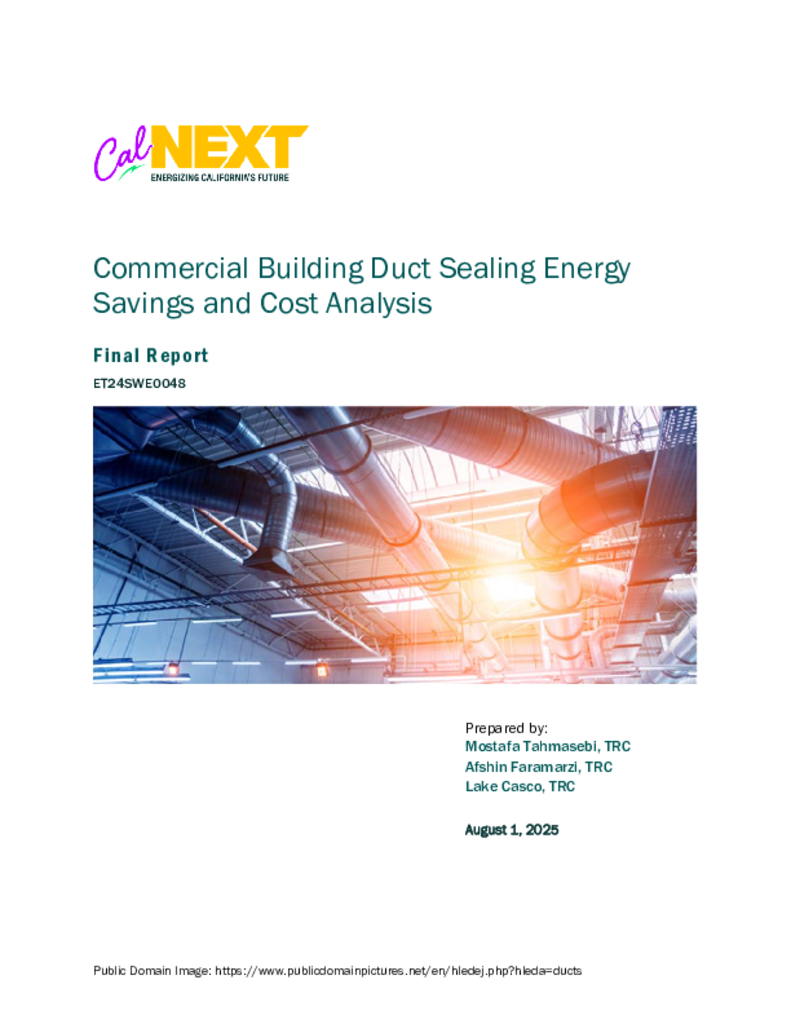ET24SWE0048 - Commercial Building Duct Sealing Energy Savings and Cost Analysis
In commercial buildings where forced-air heating and cooling systems are employed, the efficiency of ductwork plays a pivotal role in both energy management and indoor air quality. According to the U.S. Energy Information Administration's (EIA), ventilation systems in commercial buildings consume around 1.54 quadrillion British thermal units of energy consumption nationally, or roughly 29 percent of total heating, ventilation, and air conditioning (HVAC) energy use in commercial buildings1. Another study concluded that air-leakage rates in duct systems can range from 0% to 30%, with most measurements falling between 10% and 20%.
Per California Public Utilities Commission (CPUC) feedback on San Diego Gas and Electric’s (SDG&E) measure package plan for SWSV017-01 Duct Seal, Commercial measure package, this project will focus on evaluating duct sealing technologies in commercial buildings, emphasizing single zone HVAC systems for small commercial buildings serving less than 5,000 square feet of conditioned floor area. Prior field studies and energy simulations have shown duct sealing can save 12-34 percent fan energy use, leading to 2 percent electricity saving per building depending on existing HVAC system types and conditions. The goal of this project is to provide data necessary to support the development of a measure package offering by utility programs for commercial duct sealing technologies and thus increasing the adoption of effective duct sealing by HVAC professionals.
Assessing energy performance requires detailed simulations of how duct sealing affects HVAC system efficiency in commercial buildings. In addition, measure development requires defining the base case versus proposed measures and associated costs. This analysis will involve modeling different scenarios, considering varying levels of duct leakage, the effectiveness of different sealing methods in reducing these leakages and the costs of each approach.
Due to limitations in EnergyPlus for modeling duct leakage, the energy simulation outputs will be compared with secondary data sources, including existing literature and field results from other resources.
While the direct development of a measure package is not within the scope of this study, the findings directly support the development of measure packages by utility programs. In coordination with SDG&E, the project team intends to conduct a market characterization study (proposed separately) and this study as measure development support, while SDG&E will fund the measure development process separately.
This report builds on the Commercial Building Duct Sealing Market Characterization study, which identified significant energy efficiency opportunities from duct sealing technologies in small commercial buildings (J. Breda et al., 2024). Through comprehensive market analysis and field research, the prior study highlighted critical factors impacting duct configurations and leakage characteristics. This subsequent study focuses on quantifying energy savings potential through detailed energy modeling and cost-effectiveness analysis to guide targeted incentive programs.
The project team conducted EnergyPlus simulations across 16 California climate zones using standardized small commercial prototypes: small office, fast food restaurant, retail store, and restaurant dining. The simulations considered two distinct leakage modeling methods—leakage-to-inside and leakage-to-outside—to capture realistic operational and energy-impact scenarios reflective of typical small commercial buildings. Energy modeling results show meaningful energy savings, with heating, ventilation, and air conditioning system savings of up to 30 percent, depending on the leakage scenario, system type, and climate zone. In general, leakage-to-outside scenarios yielded greater savings, especially in climate zones with more extreme temperatures and in buildings with continuous fan systems, emphasizing the potential benefit of advanced sealing methods.
Cost analysis further substantiates the practicality of duct sealing measures. Manual sealing approaches, primarily mastic and tape, typically cost between $0.5 and $1.5 per square foot of building, delivering moderate leakage reduction of about 40 to 50 percent. Aerosol-based sealing, though higher in initial investment at $1 per square foot, significantly reduces leakage by 70 to 90 percent and substantially decreases labor costs, particularly in buildings where ducts are difficult to access.
Because California’s energy prices are more than double the US commercial average, duct sealing represents an unusually attractive efficiency investment in the state. Coupling utility‑funded leakage diagnostics with tiered, performance‑based rebates that buy aerosol projects down to a less than or equal to five‑year payback can unlock verifiable savings while supporting the state’s climate goals.
This comprehensive evaluation of cost versus savings and payback periods highlights duct sealing as a strong candidate for incentive programs. The substantial energy savings, combined with relatively short payback periods, demonstrate duct sealing’s effectiveness in achieving rapid energy and cost reductions. Therefore, targeted diagnostic programs and performance-based incentives tailored for sealing projects present a highly attractive investment opportunity for California's small commercial sector, supporting statewide energy efficiency and decarbonization goals.

